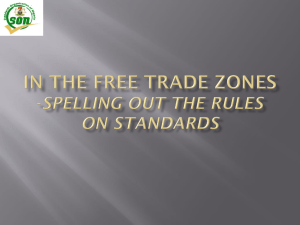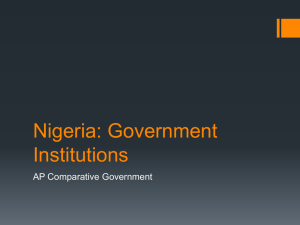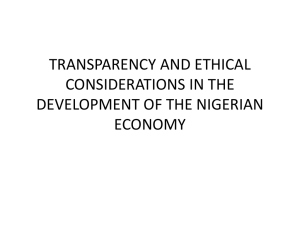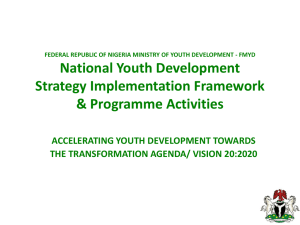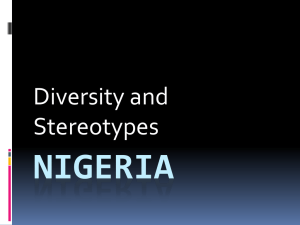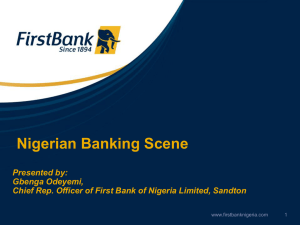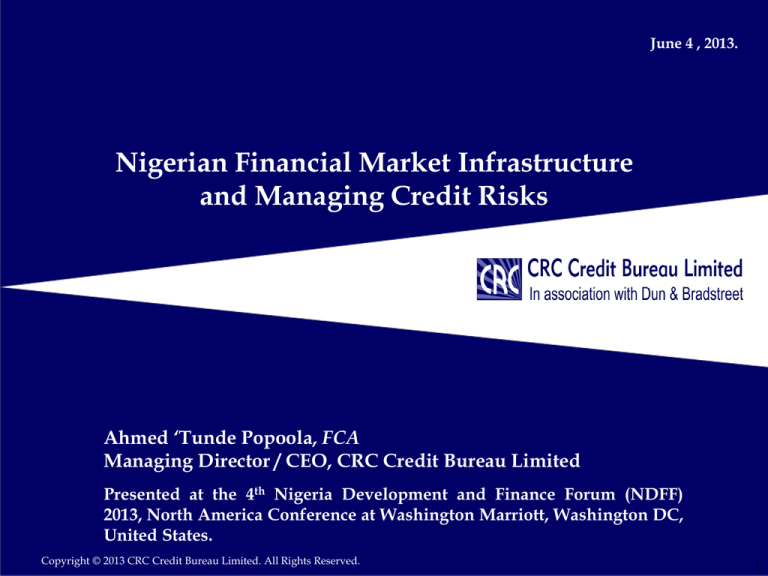
June 4 , 2013.
Nigerian Financial Market Infrastructure
and Managing Credit Risks
Ahmed ‘Tunde Popoola, FCA
Managing Director / CEO, CRC Credit Bureau Limited
Presented at the 4th Nigeria Development and Finance Forum (NDFF)
2013, North America Conference at Washington Marriott, Washington DC,
United States.
Copyright © 2013 CRC Credit Bureau Limited. All Rights Reserved.
1
Introduction
Protocols, Introductions & Welcome Remarks.
2
Presentation Outline
Introduction
Update on the Nigerian Financial System
& Recent Policy Drivers
Nigerian Financial Market Infrastructure
Managing Credit Risks
CRC’s Role as a Financial Infrastructure
Conclusion
3
Nigerian Financial System
Consolidation of the Banking System between 20032005.
The Nigerian Financial Crisis Vs Global Financial
Crisis.
Global Crisis influenced by subprime mortgages.
Nigeria Financial crisis influenced by
Capital Market burble
Foreign Investment funds flight and
repatriation.
Weak governance regime.
Nigeria is emerging strong from the crisis.
4
Capital Market Capitalisation
14
12
10
8
6
4
2
0
Market Capitalisation (=N=‘Trillion)
Jan., 2006
Jan., 2007
Nov., 2007
Mar., 2008
Feb., 2009
Dec., 2010
Dec., 2011
Dec., 2012
Apr., 2013
May., 2013
2.6
4.4
10.31
12.6
5.1
7.92
6.54
8.97
10.56
11.94
Source: Nigerian Stock Exchange
5
Nigerian Financial System Cont’d.
Central Bank of Nigeria
Deposit Money Banks:
Licensed Micro-finance
Banks
Primary Mortgage
Institutions (PMIs)
Commercial Banks
Non-interest Banks
Discount Houses
Finance Companies
Merchant Banks
Development finance
institutions (DFIs)
Bureaux-dechange
(BDCs)
Mobile
Network
Operators
Asset Management
companies
Leasing companies
6
Low Level of Financial Inclusion
Parameters
Countries
Brazil
Russia
India China
South Nigeria
Africa
Total Population
(Millions)
196.7
143
1,241
1,344
50.59
Total Value of Bank
deposits including
gold ($’Million)
352.01
497.4
298.7
3,254.7 48.75
36.3
% of Bank account
holders
62
N/A
N/A
N/A
63
32.5
ATM Coverage per
100,000 adults as at
2011
119.63
152.94
8.90
N/A
60.01
11.99
162.5
Data as at 2011
Source: World Bank 2011
7
Low Credit Penetration
Parameters
Countries
Brazil
Russia India China South
Africa
Nigeria
Domestic credit
provided by banking
sector as % of GDP as
at 2012
98.3
39.5
74.1
175
37.5
Private Credit
Bureau Coverage to
% of adults as at
2012
62.2
45.4
14.9
54.0
4.1
Source: World Bank 2012
145.5
8
Trend in Credit Penetration in
Nigeria
16
14
12
10
8
6
4
2
0
Credit to Private Sector (=N='
Trillion)
2006
2007
2008
2009
2010
2011
2012
2.57
5.07
8.06
10.21
9.83
14.18
15.14
Source: CBN, 2012.
9
Presentation Outline
Introduction
Update on the Nigerian Financial System
& Recent Policy Drivers
Nigerian Financial Market Infrastructure
Managing Credit Risks
CRC’s Role as a Financial Infrastructure
Conclusion
10
The Concept of Financial Infrastructure
Financial Intermediation
Deposits
(Surplus Zone)
Infrastructures used are:
Automated Teller
Machines (ATM)
Point-of-Sale Terminals
Mobile and Internet
Transfers
Cashless policy
Loans
(Deficit Zone)
Infrastructures used are:
Credit Bureaus
Collateral Registries
Legislation and Court
System
11
Financial Infrastructures Cont’d.
Financial Infrastructures help:
Modernise financial intermediation.
Drive financial inclusion.
Drive innovation.
Foster transparency.
Curb corruption.
Enhance efficiency in service delivery.
Reduces transaction costs.
12
Payment Structure in Nigeria
Users
Individuals, Business,
Government
Payment
Services
Providers
Channels & Product
Payment
Infrastructure
Payment
methods
Regulator
Source: EFInA, 2011
Transaction
Processing
CBN
ACH: Automated Clearing House
RTGS: Real-Time Gross Settlement System
CSCS: Central Securities Clearing System
NIBSS: Nigerian Inter-bank Settlement System
Channels
ATM
POS
Teller
Mobile
Internet
Instruments
Cash
Cheques
Cards
ACH
RTGS
Providers & Processors
Deposit Banks
Card Operators
NIBSS
CSCS
13
Cashless Infrastructure
ATMs accounts for over 80% in
e-payment
transactions.
However, cash withdrawal and
bank enquiries are the most
common transactions performed.
The level of inter-operability
among payment providers and
users have increased. With the
scrap of the N100 interbank
charges,
the use of ATM
machines
have
become
acceptable by many.
According to CBN, the number
of deployed and active PoS
terminals grew from 5,557 as at
January, 2012 to over 104,858 by
October, 2012 with over 176, 604
being registered.
14
12
10
8
ATM
Coverage
per
100,000
adults
6
4
2
0
2006 2007 2008 2009 2010 2011
Source: World Bank, 2011
14
Other Policy Drivers
Mobile Banking and Money
Transfer
Cashless Policy
Revised Microfinance Policy
Revised Prudential Guidelines
15
Presentation Outline
Introduction
Update on the Nigerian Financial System
& Recent Policy Drivers
Nigerian Financial Market Infrastructure
Managing Credit Risks
CRC’s Role as a Financial Infrastructure
Conclusion
16
Understanding Credit Risk
Understanding Credit Risk
using a simple credit cycle.
Credit risk arises due to moral
hazards and adverse selection.
For banks in general, loans are the largest and most obvious source of credit risk;.
However, there can be other sources of credit risk through the activities of a bank. Banks
increasingly face risk in various financial instruments such as interbank transactions, trade
financing, foreign exchange transactions, financial futures, swaps, bonds, equities,
options, extension of commitments and guarantees, and the settlement of transactions.
17
Laying the Foundation for Risk
Management
Collaboration among key risk management players.
Establishment of an appropriate credit risk
environment and culture.
Operating under a sound credit-granting process.
Maintenance of an appropriate credit administration,
measurement and monitoring process.
Ensuring adequate controls over credit risk and
adopting a sound internal lending policy.
Use of credit bureaus.
Use of collateral registries.
Compliance to Basel’s Accord.
18
Financial Infrastructure: Presence of
Credit Bureaus in Africa
The countries in
are those that uses
private credit
bureaus in Africa.
Ghana is the only
country in West
Africa with a
Collateral Registry.
19
Credit Bureaus in Nigeria
Credit bureaus, also known as credit information services,
credit registries, credit reporting agencies or consumer credit
reference agencies are organizations that are well established
in advanced economies. The bureau compiles information on
individuals and
corporate organization. These include
information on credit repayment records, court judgment and
bankruptcies and then creates a comprehensive reports that is
sold to business users in form of credit reports, credit scores
and other products.
Presently, Nigeria has three private credit bureaus and one
owned by the Central Bank of Nigeria. Having credit bureaus
places Nigeria in a enviable position as they have enabled the
country reach a respectable level in database coverage,
improved loan processing speed and costs, reduced selection
records and information asymmetry, reduced credit risk and
overall enhanced access to credit.
20
Function of Credit Bureaus
Credit Bureau provides complete, accurate, and reliable information
on credit status and history thus improving the ability of credit
providers to make informed lending decisions.
Banks
Business Users:
Other
financial
institutions
Insurance
Telecoms and
Utilities
Other non- financial
institutions
Public Data
Sources
Aggregated
credit
Information
Credit Reference
Reports & Scores
Banks
Non bank financial Institutions
Insurance Companies
Telecoms
Utilities
Rental Agencies
Manufacturers
Retailers
Employers
Government
Agencies/Regulators
Oil and Gas Companies
Pharmaceutical Companies
Recruitment/Consultancy
Firms
21
Challenges & Prospects
Challenges
Lack of appropriate legislation.
Irregularities in the operations of
some of the financial infrastructures
such as ATM machines and the POS
terminals.
Epileptic
internet
telecommunication services.
Incessant network failures.
Limited financial literacy.
Capacity/size of the market (long
queues at some ATM machines
especially weekends) and limited
coverage.
and
Prospects
A large market size.
An improved financial infrastructure.
Improved and well sustained reforms
in the financial system.
High investment opportunities and
service options.
Reduced risk of cash-related crimes.
Cheaper access to banking services
and access to credit.
Improved and greater financial
inclusion
and
economic
development.
Seamless multichannel integration.
22
The Future
Quick implementation of the national
identity project.
Establishment a collateral registry.
Support existing Credit Bureaus to
enable them deliver on their mandate
e.g. regulations.
The efficiency and transparency of
the judicial system.
23
Investment Finance Opportunities
Top 10 African Destination countries for infrastructure
projects, up to February, 2013
Countries
Number of Projects
Sum of capital invested
(US$ million)
South Africa
134
129, 934.0
Nigeria
106
95,480.5
Egypt
82
60,164.7
Uganda
63
17,730.3
Kenya
60
32,851.5
Algeria
34
87,154.1
Mozambique
31
32,085.0
Libya
29
20,668.4
Tanzania
29
16,185.1
Cameroon
25
8,470.8
Source: African Project Access, Business Monitor International; Ernst and Young analysis
24
Investment Finance Opportunities in
Nigeria
Project Opportunities in Nigeria are:
Transport and Logistics
infrastructure.
Housing Infrastructure.
Oil and Gas.
Power and Utilities.
Agriculture.
25
Presentation Outline
Introduction
Update on the Nigerian Financial System
& Recent Policy Drivers
Nigerian Financial Market Infrastructure
Managing Credit Risks
CRC’s Role as a Financial Infrastructure
Conclusion
26
Who We Are
CRC Credit Bureau is a private limited company incorporated in
June 2006. The Bureau was licensed by the Central Bank of
Nigeria in June 2009 and commenced live operations in the same
month.
CRC Credit Bureau provides an industry-wide information
repository on credit profiles of both consumers and corporate
entities. We are the leading credit bureau company in Nigeria
with credit information covering commercial banks, non-banking
institutions, retailers and utility providers and other credit
granting institutions.
Our main objective is to generate and supply reliable and
accurate credit information reports on borrowers in the
consumer and corporate sectors for permissible purposes.
We serve as a neutral third party service provider to our
customers and subscribers.
27
Our Shareholders
-Investor &
Technical
Partners
-Investors
28
CRC Membership Chart
Oil & Gas
Non-Interest earning
Institution
Co-operatives
Travels ,Tours
& Hospitality
Company
Recruitment/
Consultancy
Retailers
Other NonFinancial
Institutions
Insurance
Companies
Commercial
Banks
Primary
Mortgage
Banks
Microfinance
Banks
Other Financial
Institutions
Accounting/
Audit Firms
Federal
Government
Parastatal
Discount
Houses
Pharmaceuticals
Leasing
Companies
29
Products & Services
Presently
Short / Medium Term
CRC Credit Information Reports
•CRC Basic Credit Information Report
•CRC Classic Credit Information Report
For both: Consumers(Individuals),Small
Businesses and Corporate
Fraud Detection
•File Cross-referencing
•Fraud scoring
•Fraud Detection systems
Self Enquiry
Collections Management
Bulk Portfolio Requests
Credit Scoring
Credit Risk Report & Review (Referencing) Batch Screening
Data Management
Monitors & Alerts
CRC Financial Education
30
Presentation Outline
Introduction
Update on the Nigerian Financial System
& Recent Policy Drivers
Nigerian Financial Market Infrastructure
Managing Credit Risks
CRC’s Role as a Financial Infrastructure
Conclusion
31
CONCLUSION
Nigeria financial system is set for the next decade with the
aggressive adoption of financial infrastructure for financial
intermediation – payments system and access to credit
All efforts are also geared towards improving on the financial
inclusion including the introduction of mobile money
Credit bureau is set to change the face of access to lending in
Nigeria especially for consumers and SMEs who face the
challenges of access to credit
Nigerian banks are taking leadership in Africa with presence in
most attractive economies in Africa and with improvements in
size and governance
Nigeria is also a hot destination for FDIs due to environmental
friendliness, market size and stable polity
We need to address the challenge of power, internet access,
32
unique identification, legislation, etc.
THANK YOU.
33

